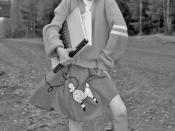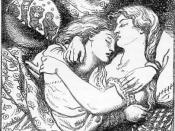Summer Reading Assignment Name: Bryce Hardy
10th Grade The House on Mango Street
Before returning to school next school year, you will need to read The House on Mango Street by Sandra Cisneros and complete this assignment. This organizer is intended to guide your reading and focus your thoughts in preparation for the discussions, summer reading quiz and writing assignments you will engage in when you return in September.
By carefully completing this assignment over the summer, you will be prepared to discuss the story in the fall, to take a summer reading quiz and to write an in-class essay using your book and packet as the basis for your responses.
A TYPED hard copy of this packet must be submitted to your teacher on the first day of school.
SECTION 1: Setting
Instructions: Esperanza's reactions to her physical environment often reveal aspects of her character. Choose three large or small elements of Esperanza's physical environment (e.g.,
houses, neighborhoods, city, school, trees, concrete, windows) and trace them as they repeat throughout the novel. In the first column, write the quotations (with their page numbers) that describe your selected elements. In the second column, write a short analysis that explores Esperanza's reaction to the element.
Physical Element One: Shoes Concrete Detail and Page Number 1. Esperanza makes the connection between shoes and sex, when she tries on high-heeled shoes. 2. When she attends the dance in brown saddle shoes, she gets embarrassed. The boys want to dance with her, but she is scared to dance with her shoes. 3. In Esperanza's vision of her dream house, her shoes are beside her bed. | Please discuss Esperanza's overall reaction to the element: For her they show the conflict she feels between her emerging sexual attractiveness and her wanting to be free. |
Physical Element Two: Trees Concrete Detail and Page Number 1. Esperanza sees the four skinny trees in her front yard and says they and her understand each other. 2. Every time she sees a tree it reminds her of her, comparing her own skinny neck and pointy elbows to the tree's small branches. 3. The tree in Meme Ortiz's backyard has a special connection with her. Even though the tree becomes dangerous, because Meme jumps from it and breaks his arms. | Please discuss Esperanza's overall reaction to the element: She shows respect for trees. She relates to trees because they don't seem to belong to anyone and because the stand tall despite the concrete that tries to keep them from growing. |
Physical Element Three: Poetry Concrete Detail and Page Number 1. Esperanza writes poems about her life. She also chants poems while she is jump roping. 2. Esperanza also likes to recite her poems not just write them down. She feels like she has a duty to let others hear her words, so she doesn't feel outspoken. 3. Minrva also rights poems, and she likes to share them with Esperanza. | Please discuss Esperanza's overall reaction to the element: Esperanza emphasizes the importance of language with poems. She has a long poem, her attempt to make some of the un-poetic aspects of her life less hard and more ordered through poetry. |
SECTION 2: Female Characters
Please examine the similarities and differences between Esperanza and three other female characters in the book. Aspects that a character shares with Esperanza (ways in which they are alike) should be written in the left-hand column; aspects that are unique to a character (ways in which the character is different from Esperanza) should be listed in the right-hand column.
Character #1 Name: Sally | |
Aspects Shared with Esperanza They are the same age. They were both interested in boys. They both change dramatically after being put in danger. | Aspects Unique to this Character She has a physically abusive father. She would rather hang out with boys than with her friends. She finds comfort in sex. |
Character #2 Name: Nenny | |
Aspects Shared with Esperanza They are sisters. They are both dreamers. They laugh at things that aren't funny. They are both very steadfast in their ideas. | Aspects Unique to this Character Nenny refuses to be creative. She dreams of making the outside of the world into the barrio. |
Character #3 Name: Mama | |
Aspects Shared with Esperanza They both grew up in the US. They both have their own way of thinking, and don't like to give up on problems. | Aspects Unique to this Character She is one of the strongest-willed and smartest women in the book, but she doesn't influence Esperanza. |
SECTION 3: Mood
Mood is the emotional effect that a text creates for the audience, the way the reader feels when reading a work. It is the atmosphere that an author creates in a literary work with the intention of evoking a certain emotion or feeling from the reader. Mood may be created by a combination of such elements as setting, diction, figurative language, and syntax.
Examples of Some Mood Words
POSITIVE MOOD WORDS | NEGATIVE MOOD WORDS | ||
amused awed bouncy calm cheerful chipper confident contemplative content determined dignified dreamy ecstatic empowered energetic enlightened enthralled excited exhilarated flirty giddy grateful harmonious hopeful hyper idyllic joyous | jubilant liberating light-hearted loving mellow nostalgic optimistic passionate peaceful playful pleased refreshed rejuvenated relaxed relieved satiated satisfied sentimental silly surprised sympathetic thankful thoughtful touched trustful vivacious warm welcoming | aggravated annoyed anxious apathetic apprehensive barren brooding cold confining confused cranky crushed cynical depressed desolate disappointed discontented distressed drained dreary embarrassed enraged envious exhausted fatalistic foreboding frustrated futile gloomy grumpy haunting heartbroken hopeless hostile indifferent infuriated | insidious intimidated irate irritated jealous lethargic lonely melancholic merciless moody morose nauseated nervous nightmarish numb overwhelmed painful pensive pessimistic predatory rejected restless scared serious sick somber stressed suspenseful tense terrifying threatening uncomfortable vengeful violent worried |
Complete the graphic organizer below. Choose three vignettes from The House on Mango Street. Determine what mood is established in each vignette. Provide a concrete detail and commentary that support your interpretation of the mood.
Quotation that reveals mood | One sentence of commentary to explains how the quote establishes mood |
Mood Word Assaulted Vignette Negative Page Number: 100 Quotation: Sally, you lied, you lied. He wouldn't let me go. He said I love you, I love you, Spanish girl. | Commentary: She repeats the accusation that her friend lied, blaming Sally for the assault instead of the boys who have hurt and traumatized her. |
Mood Word Denial Vignette negative Page Number: 106 Quotation: No, this isn't my house I say and shake my head as if shaking could undo the year I've lived here. I don't belong. I don't ever want to come from here. | Commentary: Esperanza realizes she does indeed belong on Mango Street. |
Mood Word Locked-up Vignette Negative Page Number: 9 Quotation: Until Then I am a red balloon, a balloon tied to an anchor. | Commentary: Esperanza feels like boys and girls are on two different levels. |
SECTION 4: Cisneros' Style in "My Name" (10-11)
Cisneros writes in a style that can be considered prose (novel-like), but she also employs language devices frequently found in poetry. Re-read the chapter "My Name," and find two examples of imagery, two examples of connotation, and two examples of repetition and list those in the left-hand column. In the right-hand column, discuss how each example creates a specific mood.
Concrete details of imagery Imagery is language that appeals to the five senses (taste, touch, sight, sound, smell). 1. It is like the number nine. A muddy color. 2. Esperanza as Lisandra or Maritza or Zeze the X. | How these examples create a specific mood. 1. It changes the mood to show that its less than ordinary. 2. She doesn't like her name and feels self-conscious about it. |
Concrete details of repetition Repetition is when a word or phrase is repeated. 1. In English my name means hope. In Spanish it means too many letters. It means sadness, it means waiting. 2. She was a horse woman too, born like me in the Chinese year of the horse-which is supposed to be bad luck if you're born female-but I think this is a Chinese lie because the Chinese, like the Mexicans, don't like their women strong. | How these examples create a specific mood 1. Means is said over and over again to show the many meanings for her name. 2. Chinese is repeated because she wants you to know she is talking about them. |
Concrete details of connotation Connotation is what a word suggests beyond its basic definition. The emotions and images associated with a word. 1. Until my great-grandfather threw a sack over her head and carried her off. 2. I have inherited her name, but I don't want to inherit her place by the window. | How these examples create a specific mood 1. Sack meaning moved her somewhere she didn't want to go. 2. Place meaning where she sat as her freedom was token away from her. |
Section 5: Perspective
Esperanza sees the world as both a naïve pre-teen and an insightful adult. Cite five (5) direct quotes that demonstrate Esperanza's naïveté (innocent perspective) and five (5) events that demonstrate her insight (mature perspective).
Quotes demonstrating Esperanza's naïveté 1. "And then I don't know why but I turn around and pretend that I do not care about the box so Nenny won't see how stupid I am" (Cisneros 20). 2. "I would like to baptize myself under a new name (Cisneros 11) 3. "The way she said it made me feel like nothing" (Cisneros 5) 4. "And since she comes right after me, she is my responsibility" (Cisneros 8) 5. " You want a friend, she says" (Cisneros 13). | Quotes demonstrating Esperanza's insight 1. "They didn't seem to be my feet anymore" (Cisneros 98). 2. "I have decided not to grow up tame like the others" (Cisneros 88) 3. " I have begun my own quiet war, Simple. Sure. I am one who leaves the table like a man, without putting back the chair or picking up the plate" (Cisneros 89). 4. "One day I will say goodbye to Mango. I am to strong for her to keep me here forever" (Cisneros 110). 5. " One day I will pack my bags of books and paper" (Cisneros 110). |
SECTION 6: Final Analysis
The House on Mango Street addresses numerous social issues such as housing, education, the environment, prejudice, the treatment of women, poverty, and immigrant struggles. Select three (3) key social issues that are represented in the book, provide a brief explanation of how this issue is addressed in the story and two concrete details for each.
Social Issue: Falling How the issue is addressed: Esperanza faces the same fear of falling her neighbors do, and she hopes for a different fate. | Concrete Details: 1. Angel Vargas and Meme both fall from significant heights, both with bad results. 2. Marin waits for a start to fall to change her life. |
Social Issue: Names How the issue is addressed: Esperanza places more importance on language and description than on naming alone, but her obsession with naming shows an early understanding of the importance of language. | Concrete Details: 1. Esperanza is one of the only characters with just one name-most characters have two. 2. The power of names to transform and empower fascinates Esperanza, who struggles with how to define herself. |
Social Issue: Women by Windows How the issue is addressed: Mango street has a lot of women who are trapped by their husbands, fathers, children, or themselves. | Concrete Details: 1. Esperanza's long-dead-great-grandmother married unwillingly and spent her life sitting by her window. 2. Four women in Esperanza's neighborhood are trapped in their apartments-Mamacita, Rafaela, Minerva, and Sally. |
1


